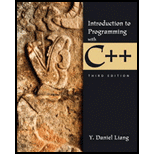
Show the output of the following statements:
Want to see the full answer?
Check out a sample textbook solution
Chapter 4 Solutions
Introduction to Programming with C++
- Prove for each pair of expression f(n) and g(n) whether f(n) is big O, little o Ω,ω or Θ of g(n). Use limits to find these. For each case it is possible that more than one of these conditions is satisfied:1. f(n) =log(n2^n), g(n) = log(sqrt(n)2^(n^2))2. f(n) =nsqrt(n) +log(n^n), g(n) =n + sqrt(n)lognarrow_forwardNeed this expression solved for mu. This can be done using a symbolic toolbox, however it needs to end up being mu = function (theta, m, L, g). If using MATLAB or something similar, run the code to make sure it works.arrow_forwardA business case scenario and asked to formulate an appropriate software design solution. Theyshould complete the case and upload the solution. will be required to read the case,identify and document the key issues, problems, and opportunities presented, and then design,and develop an appropriate integrated design solution to the problem. mustdemonstrate good spreadsheet, database, analytical, and word-processing skills whendeveloping solutions. Additionally, must be creative and demonstrate synthesising andapplying Database Management and Data Analytics Principles learned in the course. They willalso need to research some aspects of the assessment. CASE BACKGROUNDMGMT SS STATS, an umbrella body that facilitates and serves various Social SecurityOrganizations/Departments within the Caribbean territories, stoodpoised to meet the needs of its stakeholders by launching an onlinedatabase at www.SSDCI.gov. The database will provide membersand the public access to the complete set of…arrow_forward
- A business case scenario and asked to formulate an appropriate software design solution. Theyshould complete the case and upload the solution. will be required to read the case,identify and document the key issues, problems, and opportunities presented, and then design,and develop an appropriate integrated design solution to the problem. mustdemonstrate good spreadsheet, database, analytical, and word-processing skills whendeveloping solutions. Additionally, must be creative and demonstrate synthesising andapplying Database Management and Data Analytics Principles learned in the course. They willalso need to research some aspects of the assessment. CASE BACKGROUNDMGMT SS STATS, an umbrella body that facilitates and serves various Social SecurityOrganizations/Departments within the Caribbean territories, stoodpoised to meet the needs of its stakeholders by launching an onlinedatabase at www.SSDCI.gov. The database will provide membersand the public access to the complete set of…arrow_forwardUsing MATLAB symbolic toolbox, given these 3 equations, how would you solve for mu = function(theta), making sure that there are no mu's on the right hand side, making sure theta-dot-dot, theta-dot-squared- and N aren't in the final answer either.arrow_forwardAfter playing our giving implementation, your task is to implement Dinning Philosophers with semaphore in C, by including and Your implementation will require creating five philosophers, each identified by a number 0.4. Each philosopher will run as a separate thread. Create threads using Pthreads as discussed in the Lecture slides on Chapter 4 and Practice Lab on Threads. Your solution needs to accomplish the following: Implement in C (15 points) 1. dp1.c - You are to provide your solution to this assignment as a single C program named 'dp1.c using semaphore. Explain in you code (as comments) that the dead lock will happen or not. If there is a possible deadlock, you can simply solve the deadlock by pick the fork in order like the first solution in our slides. Solve Deadlock by Footman (15 points) 1. Here is a new solution to overcome the deadlock. The Dining Philosophers decide to hire a footman whose task to allow only four philosophers to sit on the table. When entering and…arrow_forward
- 8.4 Self-Bias Configuration 20. Determine Zi. Zo. and A,, for the network of Fig. 8.73 if gf, = 3000 μS and gos = 50 μs. 21. Determine Z, Zo, and A, for the network of Fig. 8.73 if the 20-uF capacitor is removed and the parameters of the network are the same as in Problem 20. Compare results with those of Problem 20. +12 V 3.3 ΚΩ HE C₂ Vo Z Zo C₁ 10 ΜΩ Z₁ 1.1 ΚΩ Cs 20 µF FIG. 8.73 Problems 20, 21, 22, and 59.arrow_forward21. Determine Zi, Zo, and A, for the network of Fig. 8.73 if the 20-μF capacitor is removed and the parameters of the network are the same as in Problem 20. Compare results with those of Problem 20. +12 V 3.3 ΚΩ +6 C₂ C₁ Z₁ 10 ΜΩ 1.1 ΚΩ Cs 20 μF FIG. 8.73 Zoarrow_forwardNinth Edition Determine Zi, Zo and Av 20 V Zi + 1 ΜΩ 2 ΚΩ HH Z IDSS= 6MA Vp=-6V Yos = 40μS 20 and 47arrow_forward
- What is the worst case time complexity of the following algorithm for i = 1 to x do for j = 2^((i-1)x) to 2^(in) do print(i,j)arrow_forwardProve for each pair of expression f(n) and g(n) whether f(n) is big O, little o Ω,ω or Θ of g(n). For each case it is possible that more than one of these conditions is satisfied:1. f(n) =log(n2^n), g(n) = log(sqrt(n)2^(n^2))2. f(n) =nsqrt(n) +log(n^n), g(n) =n + sqrt(n)lognarrow_forwardI need to make a parallel version of this sequential codearrow_forward
 C++ Programming: From Problem Analysis to Program...Computer ScienceISBN:9781337102087Author:D. S. MalikPublisher:Cengage Learning
C++ Programming: From Problem Analysis to Program...Computer ScienceISBN:9781337102087Author:D. S. MalikPublisher:Cengage Learning C++ for Engineers and ScientistsComputer ScienceISBN:9781133187844Author:Bronson, Gary J.Publisher:Course Technology Ptr
C++ for Engineers and ScientistsComputer ScienceISBN:9781133187844Author:Bronson, Gary J.Publisher:Course Technology Ptr Microsoft Visual C#Computer ScienceISBN:9781337102100Author:Joyce, Farrell.Publisher:Cengage Learning,
Microsoft Visual C#Computer ScienceISBN:9781337102100Author:Joyce, Farrell.Publisher:Cengage Learning, Programming with Microsoft Visual Basic 2017Computer ScienceISBN:9781337102124Author:Diane ZakPublisher:Cengage LearningNp Ms Office 365/Excel 2016 I NtermedComputer ScienceISBN:9781337508841Author:CareyPublisher:Cengage
Programming with Microsoft Visual Basic 2017Computer ScienceISBN:9781337102124Author:Diane ZakPublisher:Cengage LearningNp Ms Office 365/Excel 2016 I NtermedComputer ScienceISBN:9781337508841Author:CareyPublisher:Cengage EBK JAVA PROGRAMMINGComputer ScienceISBN:9781337671385Author:FARRELLPublisher:CENGAGE LEARNING - CONSIGNMENT
EBK JAVA PROGRAMMINGComputer ScienceISBN:9781337671385Author:FARRELLPublisher:CENGAGE LEARNING - CONSIGNMENT





